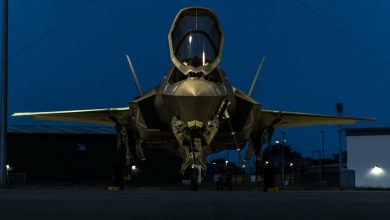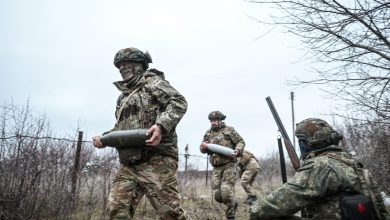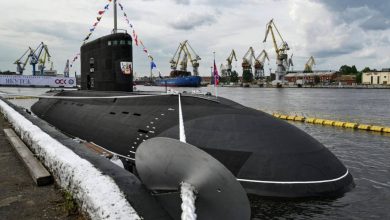Analysis: Is a real big war coming for Taiwan?

Parallels have been drawn between the war in Ukraine and a potential Chinese invasion of Taiwan. While these situations differ in many respects, both countries exist outside of a collective security apparatus like NATO, and both face existential threats posed by much larger and hostile neighbors.
Lacking nuclear weapons and outgunned in conventional terms, both the Ukrainian and Taiwanese militaries have little choice but to wage asymmetric warfare. Yet few people truly know, let alone understand, Taiwan’s current defense policy and the path forward.
Over the past five years, Taiwan has sought to adopt a defense strategy that emphasizes asymmetric warfare. In 2017, Taipei introduced the Overall Defense Concept (ODC), which articulated Taiwan’s procurement priorities and a path for structural reform. The ODC received high-level support from Taiwan’s President Tsai Ing-wen and leadership in the U.S. Department of Defense. Yet, like all major reforms, this effort faced pushback from both entrenched interest groups and generals who viewed the ODC as being overly reliant upon American intervention. Today, it is unclear if Taiwan is continuing the ODC. The Ministry of National Defense claims the ODC is still its policy, yet no one in Taipei or Washington is convinced that is so. While Taiwan is still pursuing a number of new asymmetric weapons capabilities, no one seems sure what Taiwan’s defense strategy is and what the way forward looks like for U.S.-Taiwan security cooperation. In effect, Taiwan’s military has a strategy of ambiguity.
If unresolved, the confusion over Taiwan’s strategy could drive a wedge between the United States and Taiwan. While there exists a perception that bilateral relations are possibly the best they’ve been in decades, the reality is that they appear to be worsening. Symptoms include growing voices in the United States calling for Taiwan to buy certain weapons “or else,” and attempts to legislate which systems Taiwan is (and is not) allowed to acquire. Furthermore, legislation introduced in Congress has claimed Taiwan’s force build-up suffers from a “misguided prioritization.”
Since President Joe Biden took office, his administration has denied or delayed the sale of several weapons systems to Taiwan. For example, the administration’s first approved arms sale to Taiwan was a number of M109A6 self-propelled howitzers in August 2021. By May 2022, the sale has reportedly been pushed back by at least three years. Likewise, approved in July 2019, the delivery of man-portable air-defense Stinger missiles has also been delayed. In March 2022, the U.S. State Department transmitted a letter to Taiwan explaining why it had opted to ignore Taiwan’s request to purchase MH-60R anti-submarine warfare helicopters: the system’s perceived incompatibility with their definition of asymmetric capabilities for Taiwan. The pipeline acquisition of E-2D early warning aircraft by Taiwan appears to have suffered a similar fate.
By being mistrustful of Taiwan and overly directive on matters of procurement, Washington could damage the bilateral relationship. The Taiwanese military has already experienced a history of betrayal, including the withdrawal of U.S. forces from Taiwan after the derecognition of the Republic of China (ROC) in 1979. The current approach by the United States could deepen the rift between the two militaries, which would be counterproductive in pursuit of the shared goal of deterring and, if necessary, defeating a People’s Liberation Army (PLA) attempt to annex Taiwan. Rather than being “rock solid,” it appears that U.S.-Taiwan defense relations are deteriorating. What happened? Taiwan embraced and then pivoted away from the ODC.
Whatever its merits or shortcomings, the ODC served as a common language between the United States and Taiwan. It was a clearly defined procurement prioritization and reform plan, putting forward that Taiwan needed a more balanced force buildup in terms of conventional and asymmetric capabilities. Both Washington and Taipei understood the ODC, agreed upon it, and used it as a communication platform for maintaining the status quo: the existence of two legitimate governments on both sides of the Taiwan Strait. The ODC sought to build a U.S.-Taiwan joint working group that would encourage greater senior- and working-level exchanges, including joint contingency simulations and exercises and guidance in key areas such as force restructuring, doctrinal reforms, logistical support, and operational tactics.
Such a platform could enable greater jointness and begin building the foundations for alliance management, a large part of which would be the discussion and delegation of roles and missions during different scenarios.
Unfortunately, this is no longer a point of emphasis. The ODC was a bold step forward, but without an American commitment to intervene should deterrence fail, Taiwan must be prepared to defend itself in all manner of scenarios, alone.
Taiwan faces two categories of threats from the Chinese Communist Party (CCP): coercion and invasion. Coercion, commonly referred to as gray-zone operations, is already occurring. Below the threshold of military conflict, Beijing is waging a multi-faceted coercive campaign against Taiwan that includes escalating incursions by PLA aircraft and naval ships into Taiwan’s air defense identification zone (ADIZ) and near its territorial waters. The CCP has used import and tourism bans to inflict pain upon Taiwan’s economy, and has orchestrated a sharp increase in cyberattacks and disinformation campaigns intended to manipulate hearts and minds in every pocket of Taiwanese society.
In recent weeks, the conflict in Ukraine has underscored the grim reality that coercion may get far worse, and the invasion scenario is the one that poses an existential threat. For the CCP, the annexation of Taiwan is central to its “great rejuvenation of the Chinese nation.” This is nothing new: destroying the ROC government and conquering Taiwan has been the PLA’s core mission for decades. If coercion fails to induce capitulation, the CCP could launch a full-scale invasion to occupy Taiwan. Barring nuclear annihilation, this is the most dangerous scenario for Taipei. However, Taiwan’s military is arguably less prepared for an invasion than it is for countering coercion, and both threats are worsening.
China’s meteoric economic rise has allowed Beijing to invest heavily into a massive military buildup. After years of investment, the PLA today enjoys a growing qualitative and quantitative advantage over Taiwan’s military. China’s population is sixty times greater than Taiwan’s, and Beijing’s totalitarian system allows it to extract private resources to further military objectives. Given this disparity in both actual and latent capability, it is inconceivable that Taiwan could directly redress this imbalance. By 2027, the Chinese military could be capable of successfully attacking Taiwan, as former U.S. Indo-Pacific Command commander Admiral Philip Davidson testified before Congress. Unless the United States plans to actually defend Taiwan, the PLA could be optimally positioned to invade as soon as 2025, according to Taiwan’s Defense Minister Chiu Kuo-cheng. How to effectively allocate limited material and time resources is a key issue.
For these reasons, the ODC focused primarily on the invasion scenario. It was a strategy for how Taiwan should effectively allocate limited resources to defend itself, exploiting PLA vulnerabilities to the point that the success of Beijing’s amphibious attempt would be in serious doubt. The ODC sought to integrate force buildup directly with its concept of operations. It stipulated that large, expensive weapon systems could be effective during peacetime against coercion, but that asymmetric weapons would be critical during war. Asymmetry is relative, and as perspectives and conditions can vary widely, a definition is essential. The ODC defined asymmetric defense capabilities for Taiwan as mobile, resilient, lethal, cost-effective, numerous, and survivable. As Taiwan has historically invested less in such asymmetric capabilities compared to conventional platforms, the ODC called for a greater emphasis on the former. But importantly, military investments were not considered a binary choice. Planners in Taiwan’s Ministry of National Defense believe they need a mix of conventional and asymmetric capabilities. Both types of systems are important for Taiwan in the absence of assured security arrangements with the United States.
Taiwan’s defense architects envision a PLA attack starting with devastating missile strikes followed by an all-out amphibious invasion. They anticipate that this could occur regardless of whatever amount of punishment Taiwan is able to inflict on targets in China. Counterstrikes against critical military nodes (such as Chinese ports) are implied, as it would be both a strategic and operational mistake to sit back while the PLA mobilizes and loads its invasion fleet. Nonetheless, once the war starts, Taiwan could run out of long-range missiles within days, leaving Beijing free to choose the best time, place, and manner to launch its amphibious landing campaign.
Taiwanese units employing short-range weapons could hide during the first phase of missile strikes and maintain the capacity to strike back against amphibious landing platforms and other sea lift assets as they closed in on Taiwan. The most vulnerable points for the PLA would be in transit and disembarkation. In an era of smart missile technology, ships at sea make for large, slow targets. Taiwan’s joint fire strikes from air, sea, and shore assets would focus on sinking the invasion ships in the littoral. Ground forces could then mop up disorganized and stunned PLA units on the landing beaches. If all went to plan, this would be the natural progression of a failed Chinese invasion. But what if the Taiwanese plan failed?
Taiwanese plans call for a defense in depth. The ODC aimed to reform the reserve force and separate its form and function from the regular military, creating an all-volunteer territorial defense force that would be trained in a decentralized command and communications denied environment. Light weapons and equipment would be stocked locally for immediate access upon mobilization. If the PLA successfully lands on Taiwan’s beaches, the territorial defense force would conduct anti-airborne missions and defend critical infrastructure and urban areas. Such units would serve a key role in a prolonged insurgency.
With no published National Security Strategy, Taiwan’s latest National Defense Report is the most authoritative source available for understanding Taipei’s vision. Released in November 2021, that document has no mention of the ODC and instead reverts to using vague terminology to describe Taiwan’s military strategy as “resolute defense and multi-domain deterrence.” But then it precisely outlines four different defensive stages should the PLA attempt to invade. First, Taiwan’s military would conduct denial operations at enemy points of embarkation. Second, Taiwan’s military would conduct strike operations at sea. Third, Taiwan’s military would conduct attack operations as the enemy offloaded ships. Fourth, Taiwan’s military would seek to totally annihilate enemy troops that make it to the landing beaches.
To accomplish these missions, Taiwan aims to emphasize long-range strikes, counter-air operations, sea control, homeland defense, ICE (information, electronic, and cyber) warfare, and joint C2ISR (command, control, intelligence, surveillance, and reconnaissance). These force buildup goals are consistent in both the 2021 National Defense Report as well as the 2021 Quadrennial Defense Review, with the latter strategy document specifically emphasizing air superiority as part of counter-air operations. Indeed, both reports borrow language from the ODC, especially in sections regarding asymmetric weapons. To be clear, these delineated areas of force buildup are all important. However, the report lacks the clear prioritization the ODC provided, as well as the ways and means to achieve strategic end states. With limited resources and time, what is most important for Taiwan’s defense and how will Taiwan achieve these objectives?
Official plans for reserve reform are focused on planning for mobilization and increasing training. To this end, the National Defense Report stresses merging the reserve and mobilization management systems as one, achieving unity of regular and reserve forces, and promoting interagency cooperation. In December 2021, the Ministry of National Defense (MND) officially established the All-Out Defense Mobilization Agency which appears primarily geared toward mobilization planning. Reserves training has been increased from seven days to two weeks, and the MND is seeking to increase the number of “special reservists.” It is without a doubt that mobilization and training are key operational aspects that must be strengthened. Public polling indicates support for reinstating extended conscription service. Yet it is no secret that Taiwan’s reserve force suffers from deep structural challenges. Increasing the quantity of training is vital, but without addressing issues such as the nature and quality of reserves training, readiness, and missions, it is unclear what the fully reformed reserve force would look like and how effective it could be.
While arms sales are important, it is arguably even more critical for Taiwan to have a clearly outlined defense strategy for its people (and the Americans) to understand. “Asymmetric weapons” are ineffective for asymmetric warfare without integrating concepts of asymmetry into strategic, operational, and tactical levels. This is what the ODC hoped to achieve. Whether the ODC is reinstated or replaced with a new concept, time cannot be wasted on misunderstanding and fruitless debate. The only beneficiary of a confused Taiwanese public and weakened U.S.-Taiwan defense relations is Beijing. At the same time, Washington needs to understand that a PLA amphibious invasion is only one of many possible scenarios, and Taiwan’s efforts must concurrently be invested in other important areas, including military readiness and the political dimensions of the China threat. It would be a mistake to solely focus on the invasion scenario.
Russia’s invasion of Ukraine should be a wake-up call for both the United States and Taiwan. Unlike Ukraine, Taiwan is not a widely-recognized nation-state with a seat at the United Nations and an embassy in Washington. At the current time, Taiwan’s diplomatic relations with the U.S. are considered “unofficial,” and it is unclear how the White House will react if China attacks Taiwan. The Biden administration has said its commitments to Taiwan are “rock solid,” without defining what that means. President Biden has stated that the United States could military defend Taiwan during a contingency, yet this has been walked back by the State Department.
The Biden administration has repeatedly stated that U.S. policy toward Taiwan has not changed and that strategic ambiguity towards Taiwan remains. But with the global threat picture darkening, the United States and Taiwan would do well to work more closely together to deter a Chinese attack and, if necessary, defeat it. In the absence of an American policy of strategic clarity and commitment to defend Taiwan, both countries will struggle to develop a clear division of labor. Nonetheless, they could take steps to develop notional roles, missions, and responsibilities for possible ad hoc coalition operations. And they could rapidly expand bilateral training and increase the scope of liaison missions.
The United States and Taiwan could also initiate the prepositioning of American military equipment to help bolster readiness as quickly as possible, modeling of the existing War Reserve Stocks for Allies (WRSA) program with Israel. Equipment would be owned by the United States and maintained by the host nation, initiating a foreign military sale only if transferred to Taiwan. Separate stockpiles could be established for the United States and Taiwan militaries. American depots could hold equipment supporting the sustainment of joint force partners across the Indo-Pacific. Taiwanese depots could hold munitions, spare parts, and other items that would help address shortages and procurement challenges for key defense equipment. Such bilateral cooperation would substantively boost readiness against the pacing challenge for the American and Taiwanese militaries.
Near-term efforts to counter the PLA threat, such as a WRSA program for Taiwan, should be expanded alongside long-term efforts, such as establishing a senior-level, bilateral defense industrial supply chain steering group geared toward addressing structural problems in the U.S.-Taiwan defense relationship in confronting shared challenges. Such a policy coordination mechanism would identify Chinese defense research and development (R&D) trends to identify single points of failure and maintain a qualitative military edge in key areas; promote cooperative R&D and examine opportunities for joint production, sustainment, and follow-on development of defense equipment; provide a forum for procurement of Taiwan’s technology, equipment, systems, or logistics support solutions that uniquely meet U.S. needs; and enhance Taiwan’s defense readiness through careful indigenization of repair and maintenance.
All in all, Taiwan must prepare for all manner of coercive and annihilative scenarios and deploy capabilities that support these missions. The United States appears to be gearing Taiwan to prepare for war without making clear if war is coming. Without a clear commitment from the United States, it is unclear if any allies and partners would fill capability gaps for any use of force scenarios. It would be in the national interest of both the United States and Taiwan to have some semblance of strategic clarity, whether publicly or privately, so that roles and missions can begin to be established for a potential Chinese invasion as well as other scenarios along the entire peace-war continuum. If operational plans are being rewritten, coordination would enhance the effectiveness of such planning. Leaders in Washington and Taipei sometimes forget that the defense of Taiwan is about much more than simply arm sales. If time is really as critical as it is claimed to be, both sides should start acting like it. And this starts with speaking a common language.





